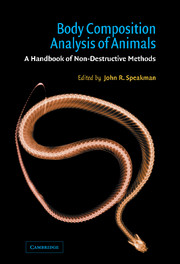Book contents
- Frontmatter
- Contents
- List of contributors
- Preface
- Acknowledgements
- Introduction
- 1 Morphological indicators of body condition: useful or wishful thinking?
- 2 Standard methods for destructive body composition analysis
- 3 The isotope dilution method for the evaluation of body composition
- 4 Gas dilution methods: elimination and absorption of lipid-soluble gases
- 5 The use of total body electrical conductivity (TOBEC) to determine body composition in vertebrates
- 6 The use of bioelectrical impedance analysis (BIA) for estimation of body composition
- 7 The assessment of body composition and other parameters by ultrasound scanning
- 8 The use of dual-energy X-ray absorptiometry for the measurement of body composition
- Index
6 - The use of bioelectrical impedance analysis (BIA) for estimation of body composition
Published online by Cambridge University Press: 19 January 2010
- Frontmatter
- Contents
- List of contributors
- Preface
- Acknowledgements
- Introduction
- 1 Morphological indicators of body condition: useful or wishful thinking?
- 2 Standard methods for destructive body composition analysis
- 3 The isotope dilution method for the evaluation of body composition
- 4 Gas dilution methods: elimination and absorption of lipid-soluble gases
- 5 The use of total body electrical conductivity (TOBEC) to determine body composition in vertebrates
- 6 The use of bioelectrical impedance analysis (BIA) for estimation of body composition
- 7 The assessment of body composition and other parameters by ultrasound scanning
- 8 The use of dual-energy X-ray absorptiometry for the measurement of body composition
- Index
Summary
Introduction
Methods for determination of body composition that are based on the electrical properties of the body include total body electrical conductance (TOBEC: Chapter 5) and bioimpedance analysis (BIA). In this chapter I focus on BIA, more specifically on single frequency BIA (SF-BIA) and multifrequency BIA or bioimpedance spectroscopy (BIS). Once the instrument has been purchased, both SF-BIA and BIS are cheap, and very user and subject friendly. Though the accuracy and usefulness of the methods are still under debate, they are being used increasingly in studies of humans, including sports, clinical work and basic metabolic studies. There have been surprisingly few studies performed in animals.
Bioimpedance analysis belongs to the descriptive methods on a molecular level. Descriptive methods are those that are characterized by a reference method, a well-characterized subject group, and a prediction equation (Wang et al., 1995; Marken Lichtenbelt & Fogelmholm, 1999a). As will become clear in this chapter, BIS has a more functional relation to the water compartments of the subjects than does SF-BIA.
Measurements of electrical conductance in biological tissues date from the end of the nineteenth century (Nyboer, 1959; Baumgartner et al., 1990). The use of bioimpedance for body composition is more recent and was developed by Thomasset in 1962. He used a two-needle electrode configuration at a fixed frequency. Hoffer et al. (1969) applied the four-surface electrode method at 50 kHz for measuring TBW. This approach was extended by Nyboer to estimate fat-free mass (FFM=lean mass: LM) and percentage body fat (Nyboer, 1981).
- Type
- Chapter
- Information
- Body Composition Analysis of AnimalsA Handbook of Non-Destructive Methods, pp. 161 - 187Publisher: Cambridge University PressPrint publication year: 2001
- 8
- Cited by

